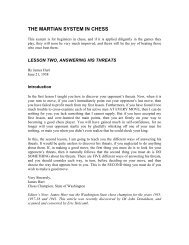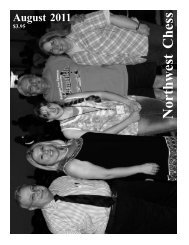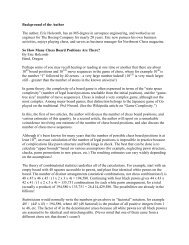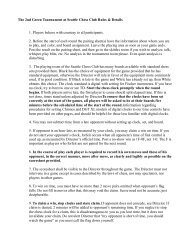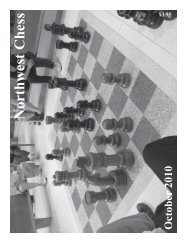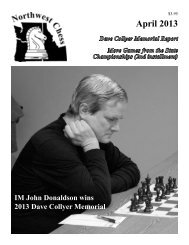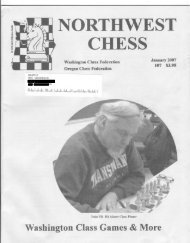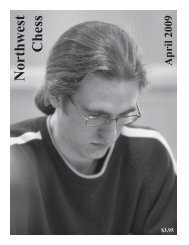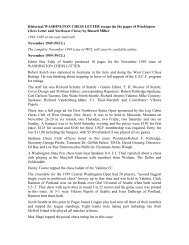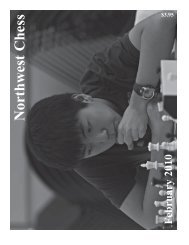Create successful ePaper yourself
Turn your PDF publications into a flip-book with our unique Google optimized e-Paper software.
Bogo Indian:<br />
1. d4 Nf6<br />
2. c4 e6<br />
3. Nf3 Bb4+<br />
4. Nbd2 c5,<br />
Part 1<br />
Players who have placed their faith in<br />
the Nimzo Indian have always known the<br />
ugly necessity of contending with 3. Nf3.<br />
For many this wasn’t a matter of fear as of<br />
annoyance. Black’s original choices were to<br />
revert to the Queens Gambit with d5, play<br />
the rather dull Queens Indian or go with Bb4<br />
entering the Bogo. Time marched on and<br />
with it some further discoveries came along<br />
like playing 3. ...c5, 3. ...Nc6, 3. ...a6 or even<br />
3. ...Ne4! Any of these provides practical<br />
chances, but many Nimzo players are left<br />
with only the original options. The Bogo<br />
Indian with 3. ...Bb4+ has remained near the<br />
center of consideration because of flexibility<br />
and resilience. At least, that is what drew<br />
me to it.<br />
After 1. d4 Nf6 2. c4 e6 3. Nf3 Bb4+,<br />
White chooses 4. Nbd2 as the most dynamic<br />
retort. White has two pawns in the center<br />
on the fourth rank and the black Bb4 seems<br />
to be ever so slightly vulnerable. The<br />
possibility of having the center and the two<br />
bishops makes Nbd2 a natural choice. Of<br />
course, Black’s thoughts are quite different.<br />
With no initial commitments beyond the<br />
Bb4, Black has almost a catalog of choices<br />
from which to select. One of the choices that<br />
I am interested in is based on Black’s tiny<br />
lead in development. With 4. ...c5, Black<br />
reaffirms intentions in the center as well as<br />
offering the Bb4 a bit of support. This is the<br />
starting point.<br />
Theoretically Speaking<br />
by Bill McGeary<br />
different general approaches after<br />
exchanging Bb4 for Nd2: keep to the<br />
standard of arranging a dark square pawn<br />
phalanx with d6/e5 or b6/d6 and maybe a<br />
later e5, or Black can look to exchange<br />
c5xd4 drawing a White piece into the center<br />
and then gaining time by harrassing that<br />
piece. Obviously, this latter approach has a<br />
much more tactical character which makes<br />
it a refreshing change for some players.<br />
Eric Prie – Viktor Korchnoi<br />
First Meudon Open<br />
Meudon, France, 1984<br />
1. Nf3 Nf6 2. c4 e6 3. d4 Bb4+ 4. Nbd2<br />
c5 5. a3 Bxd2+ 6. Qxd2 cxd4 7. Qxd4 Nc6<br />
8. Qh4<br />
This move doesn’t take into<br />
consideration Black’s ideas. On h4 the white<br />
queen is looking to instigate some kind of<br />
trouble for the black king, but with only<br />
minimal support from the rest of the army<br />
this seems too optimistic. In fact, White’s<br />
king is the more vulnerable and that becomes<br />
evident in short order. Most likely the best<br />
move for White is 8. Qc3.)<br />
White isn’t<br />
completely lost<br />
yet, but it’s close.<br />
The disparity on<br />
the board is the<br />
activity and<br />
coordination of each army. White’s men tend<br />
to threats and work individually to keep from<br />
further disaster. Black’s pieces cooperate to<br />
find further gains. Optically it appears that<br />
neither side really has much of a space<br />
advantage, but considering the positions of<br />
the white king and black queen it feels as if<br />
White is severely cramped. That is a<br />
consequence of the piece activity and<br />
coordination.<br />
14. Nd2 Nxe2 15. Kxe2 d5 16. cxd5<br />
exd5 17. Re1 b6 18. f4 Re8 19. Kf1 Qd3+<br />
20. Kf2 Ba6 21. Nf3<br />
Regular choices at move five for White<br />
are 5. e3 or 5. a3. With 5. dxc5 White<br />
8. ...0-0 9. Bg5 Qa5+ 10. Bd2 Qf5 11.<br />
exchanges a center pawn for almost no<br />
e3 Qc2<br />
reason, which is enough for Black to smile Here is a case of creative accounting.<br />
and consider it a minor victory. Pushing 5. White used two moves to get the Bc1 to d2<br />
e3 White is happy to tend to business and while Black used 3 moves to get Qd8 to c2,<br />
see what ideas Black has, expecting to come yet which has better prospects? Again, it is<br />
to a more definite course of action a bit later the relative security of the king that makes<br />
on. That leaves the move that most directly one more effective than the other, king safety<br />
questions Black about the choice of 4. ...c5, that follows from Black developing pieces<br />
namely 5. a3. Black will be compelled to in the first moves of the game while White<br />
part with the black square Bishop and then attended to long range concepts.<br />
21. ...d4 22. Bd2 dxe3+ 23. Bxe3 Qc2+<br />
24. Kg1 Qxb2 25. Qf2 Qf6<br />
tend to weaknesses like d6. Black has two 12. Bc1 Ne4 13. Be2 Nc3!<br />
Page 12 <strong>Northwest</strong> <strong>Chess</strong> August 2009



